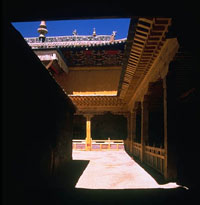The Shalu Monastery is located 20 kilometers (12 miles) south of Shigatse. The monastery was founded in 1040 by Chetsun Sherab Jungnay in the region of Nyangro near the present day town of Shigatse. In the early fourteenth century it became the most important centre of learning under Butön Rinpoche (1290-1364 ), one of Tibet's greatest scholars.
The story of its founding involves Chetsun and his teacher. His teacher suggested that Chetsun shoot an arrow, and found a monastery where the arrow hit. The flying arrow hit a new bud. The monastery was named Shalu, meaning "new bud" in Tibetan.

Shalu Monastery, Shigatse, TibetIn 1320, Buton Rinpoche became abbot of the monastery. Buton was one of the greatest religious scholars of his time. His knowledge covered a wide range of religious subjects. So did the library that he assembled. He brought together 108 volumes of the fundamental texts of Buddhism, including the Kanjur and Tenjur sutras, plus 200 volumes of "treaties and commentaries". Over 3,000 monks were attracted to his teachings. Because he had no interest in politics, however, his sect was not politically very influential.
Shalupa, also known as Butonpa, took form under Buton's leadership. Shalupa included magical feats that monks learned to do. Some monks wore very little clothing in cold weather. They were able to raise their body temperatures to such a level that warm clothing was not needed. Other monks were able to run by leaping superhuman distances. This enabled them to cover long distances without rest.
The monastery is architecturally distinctive. In 1329, an earthquake destroyed the monastery. In 1333, Buton rebuilt it under the patronage of the Chinese Mongolian emperor. Since many Chinese Han artisans participated in rebuilding the monastery, the style combined the local Tibetan style with the Chinese style of the Yuan Dynasty. This is the only monastery in Tibet that combines these styles.
Shalu Lakhang is the central hall of the monastery. Other buildings of the monastery surround it. On the ground floor, the Tschomchen (also a hall) enshrines Sakyamuni and his disciples. Sakyamuni was one of the Buddhas. The chapels flanking the Tschomchen house Tanjur and Kanjur, two very important sutras of Tibetan Buddhism. Chapels in the roof floor are of typical Chinese blue tile design. The chapels enshrine Sakyamuni, Shalu Monastery's own Buton, and the Arhats. Arhats are those who have attained enlightenment, but whose rank and power is lower than that of a Buddha. Massive, delicately painted murals cover the walls of the monastery. Most of the murals depict stories from the life of the Buddha. The murals badly need restoration to preserve and protect them.

Shalu Monastery has four religious treasures. One is a sutra board, which is 700 years old and cannot be reassembled if it is ever broken apart. A passage of sutra is printed on the board and is believed to bring good luck. The second treasure is a brass urn. It contains holy water that can cleanse away the 108 filths of human existence. The urn is usually sealed and covered with red cloth. The water is changed every 12 years. The third treasure is a stone basin that was once Chetsun Sherab Jungnay's washbasin. The fourth treasure is a stone tablet on which the mantra "om mani Padme Hum" is written and four dagobas are carved. It was uncovered during the original construction of the monastery.
About the city of Shigatse
Shigatse, also Xigatse, means "fertile land" and stands at the junction of the Yarlong Tsangpo and Nyangchu River. It used to be the capital of Tsang and now is the capital of Shigatse prefecture. The 600 year old city is the traditional seat of the Panchen Lama, who is one of the two prestigious spiritual leaders in Tibet and the abbot of the Tashilhunpo Monastery. About 300 km from Lhasa, it is an important stop between Lhasa and west Tibet where pilgrims and tourists often wander. Shigatse has a population of over 80,000, of which 97% are Tibetan. It is the second largest city within Tibet has undergone large scale development. Most tourist facilities stand along Jiefang Dong Lu, Beijing Bei Lu, Zhufeng Lu and Shandong Lu. West of the market and below the Dzong is the old Tibetan quarter where many people like to visit.
Climate
Summer is usually mild and wet, and brings most of the annual rainfall. Winter is cold, dry and windy.
Shigatse Hotel ,TibetFeature: There are wonderful monasteries comparable with those in Lhasa, like Tashilhunpo, Sakya and Shalu. The highlight of Shigatse is surprisingly high snow capped peaks. Most of the highest peaks in Tibet, including Mt. Everest, are around Shigatse, in Shigatse prefecture.
Accommodations
Although Shigatse is the second largest city in Tibet, the accommodation options are limited. Shigatse Hotel (Tel: 0892-8825525 Fax: 0892-8821900) is the best (3 star) hotel in town and is found on Jiefang Zhong. Lu. Zhufeng Friendship Hotel (Tel: 0892-8821929) on Dechen Potrang Lu is another good choice although it is some distance from the center of the city. Sangzhuzi Hotel (Tel: 0892-8822252) and Tenzin Hotel are hostels, providing basic accommodation. Tenzin has recently undergone renovations. Shigatse Post Hotel and Fruit Orchard are other choices. The Fruit Orchard is just opposite to Tashilhunpo Monastery.
Restaurants
Restaurants can be found on Kesang Ke Lu, Zhufeng Lu, and Tsendu Lu.
Entertainment
At present there is little tourist entertainment in Shigatse. On Shandong Lu, there is an internet access where there are about 20 PCs.
Practical Tips
This is your last chance to stock up some Chinese money before you reach Zhangmu. The Bank of China near Shigatse Hotel accepts travelers' cheques but does not accept credit cards. The post office handles international letters and faxes, but does not accept parcels. Shopping in the open market is an interesting experience for most people.



